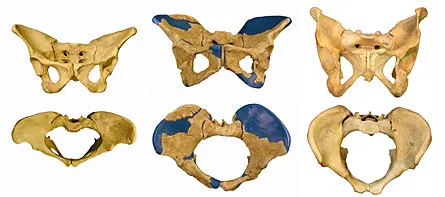She was short, squat and definitely not built for speed. On the plus side, this adult female Homo erectus, who lived in Africa roughly one million years ago, had hips wide enough to bear babies with brains nearly as big as those of newborn human infants.

That’s the evolutionary picture presented by researchers who have unearthed a rare find: a nearly complete female H. erectus pelvis. Pieces of the fossil were found at an Ethiopian site called Gona in 2001 and 2003.
H. erectus females evolved a pelvis of a size unprecedented among human ancestors because the females had to squeeze increasingly big-headed babies through their birth canals, concludes a team led by anthropologists Scott Simpson of Case Western Reserve University in Cleveland and Sileshi Semaw of Indiana University in Bloomington.
In the Nov. 14 Science, the researchers say that the new pelvis challenges an earlier proposal that both sexes of H. erectus evolved to grow relatively tall and slender in order to shed body heat efficiently in their tropical homelands. That idea was largely based on measurements of a 6-foot-2-inch H. erectus skeleton found in 1984 that has been attributed to a slim, 10- to 12-year-old boy who lived in eastern Africa 1.5 million years ago.
“It’s now apparent that body size range in H. erectus has been underestimated,” Simpson says. The Gona female lived between 1.4 million and 900,000 years ago and stood no taller than 4 feet, 9 inches. Fossil evidence of other small-bodied H. erectus individuals in Africa and Central Asia has accumulated over the past several years.
Simpson also views the broad, flaring Gona pelvis as a challenge to an earlier proposal that H. erectus individuals possessed narrow hips suitable for endurance running, a capacity that would have aided them in hunting.
The ancient Gona female, known to be an adult based on the development of the pelvis, had wider hips than virtually all women today. Given the size and shape of the new pelvis, H. erectus infants must have been more than 30 percent larger at birth than has usually been assumed, in the scientists’ view. During childhood, H. erectus brains grew at a faster pace than the brains of chimpanzees but at a slower rate than the brains of modern humans, the team estimates. And though the hips in H. erectus were bigger than the hips of H. sapiens, the size of the birth canal may have been similar for the two species.
Anatomical similarities link the Gona find to remains of other fossil female pelvises — including one from Lucy, a 3.2-million-year-old Australopithecus afarensis individual found in eastern Africa, and another from a 2.5-million-year-old Australopithecus africanus individual unearthed in southern Africa.
“I do not see any major problems with either the reconstruction or the interpretation of this new specimen,” comments anthropologist Owen Lovejoy of Kent State University in Ohio.
“This pelvis is a nice addition to the fossil record, but it raises more questions than it answers,” remarks Harvard University anthropologist Daniel Lieberman, a proponent of endurance running as characteristic of H. erectus.
In his view, the new specimen might come from a comparably ancient species in the human evolutionary family, Australopithecus boisei. A big, and therefore probably male A. boisei, could have had hips as wide as those of the Gona individual, Lieberman suggests.
A. boisei fossils have not been recovered at or near Gona, Simpson responds. A stone tool recovered along with the new pelvis corresponds to those known to have been used by H. erectus, he adds.
Other researchers say the volumes of fossil brain cases provide reliable estimates that H. erectus females delivered babies with brains about 15 percent smaller than the maximum figure cited in the new study. But Simpson says that his team’s estimated range of possible brain sizes for H. erectus babies overlaps with others’ estimates.
Finally, Lieberman remains skeptical of Simpson and Semaw’s conclusion that H. erectus was characterized by extremely short and wide females and unusually tall and narrow males, as indicated by the boy’s skeleton. “I need to be convinced,” he says.
Intriguingly, Simpson notes, modern human females have evolved relatively short statures and broad hips in cold environments, not in hot ones similar to Gona. Although H. erectus inhabited a variety of environments, females of that species retained a broad pelvis wherever they lived, he hypothesizes.
Other H. erectus fossils display traits that would have enabled endurance running, such as attachment spots for large upper-leg muscles and enlarged inner-ear structures for improved balance, Lieberman says. Long-distance running enabled H. erectus to hunt effectively without spearheads and to obtain enough meat to support the evolution of increasingly large brains, he proposes.
Simpson disagrees. The endurance-running hypothesis crucially depends on the H. erectus boy’s reconstructed skeleton, he notes. But, he predicts, a revised reconstruction would show that this youth had a broader, more flared pelvis than has been claimed.






